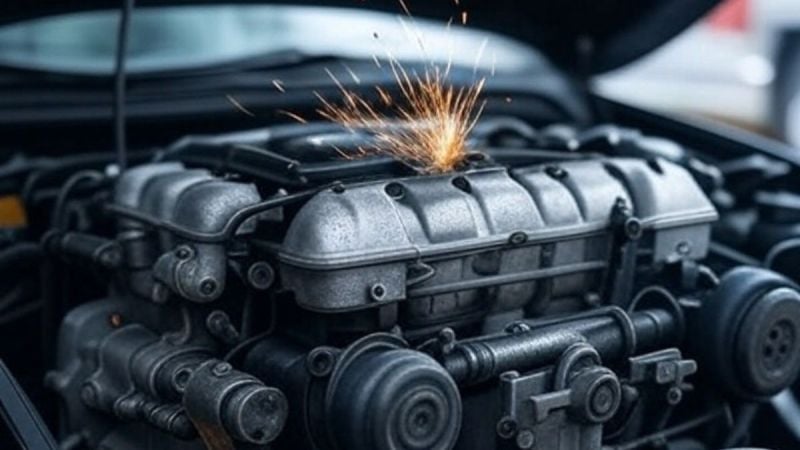Things are very interesting at Toyota, the past few years. Between Gazoo Racing sprinkling some of their magic onto a wide variety of models and the brand bringing back iconic nameplates like the Celica, it seems now is the best time to look at what Toyota is cooking.
That said, it can't always be perfect, and even the brand's most popular, mass-produced models can, occasionally, experience problems. What's more alarming is that some owners of the 2025 Toyota Camry have persistent issues that their dealership can't seem to sort out.
My latest find in the Toyota Nation forum is about a slightly older model – a 2019 Camry XSE, which isn't a hybrid. Here's what the owner says:
“Hello, everyone. I was reaching out as recently I ran into a problem with my car having a misfire. About a month ago, on May 8th, I started my car, and the check engine light came on and that causes all these other warning lights to come on I took it to get scanned, and it's cylinder 1. I replaced all spark plugs and changed the ignition coil for just cylinder one. After that, all the other warnings shut off, and after having the battery disconnected, the code cleared, and the car ran great, a little shaky on the idle and has been for a bit.
Fast forward to currently and yesterday I start my car and it runs fine for like a minute then all of a sudden all the same warnings pop up check engine which causes the others to go off I scan the engine and it's a cylinder 1 misfire again I’m not sure as to what this could be from but few days prior I felt like the car had way less power on the highway trying to accelerate like it was struggling to pick up the speed to meet highway speeds. Please, any help is appreciated as I'm confused about what this could be, and I want to try and figure it out before I resort to paying 200 at the dealership to just get it looked at. Thank you.”
Existing issue and service bulletin
This owner's 2019 Toyota Camry is, by no means, an isolated case. The Japanese carmaker issued a technical service bulletin (T-SB-0010), in February 2024. Here is a description of the issue:
“Some 2021 – 2022 model year Avalon, 2018 – 2024 Camry, and 2019 – 2024 RAV4 vehicles with A25A-FKS engines may have a MIL ON condition with one or more of the following Diagnostic Trouble Codes (DTCs) upon cold soak start up with engine coolant temperatures between 14°F – 41°F (between-10°C and +5°C).”
The issue is accompanied by the following codes:
- P030027 – Random/Multiple Cylinder Misfire Detected (Emission) Signal Rate of Change Above Threshold
P030000 – Random/Multiple Cylinder Misfire Detected
P030100 – Cylinder 1 Misfire Detected
P030200 – Cylinder 2 Misfire Detected
P030300 – Cylinder 3 Misfire Detected
P030400 – Cylinder 4 Misfire Detected
In short, the technical service recall replaces the valve lash adjuster assemblies (valve lifters) on the exhaust side. The problematic part (number 13750-F0010) is replaced by an improved part (number 13750-70020).
Useful methods and insights

If you are DIY-inclined, the good old ignition coil replacement could work. On a transversely-mounted inline-four engine like one the Camry, the coils are usually easily accessible. Switching the coil packs from one cylinder to another is a sure method to determine if you have a bad coil.
Fellow forum members have chimed in with some great suggestions as well as personal experience with similar issues.
One group member that goes by the alias Invader says: “It could possibly be due to leaking port and/or direct fuel injectors which tends to manifest itself by about 90,000 miles... I've already replaced all of my port and direct fuel injectors for about 20X less than from a Toyota dealer.”
Sdspeed says: “So just a P0301 code? Swap that coli with one next to it and see if the code follows. What brand was the replacement coil? And what are you working on?”
Another suggestion comes from a user that goes by Tonytoshiba, who had an unlikely, but very unpleasant cause for the same issue: “We had been driving our handi-van for a month or so, and my Toyota was resting in our driveway.
On restart it ran horribly. Dashboard alarm lights, some solid, some blinking, some on, then go off, then come back on.
It ended up that rats had moved in under the intake manifold. They chewed on the injector wires.
I replaced a couple injectors, repaired wires, and most of the alarms were cleared.
I had to go to the dealer as two alarms required their Toyota computer I/F to clear.
Hoping your solution is easy.”
Avian chimes in with another suggestion: “....and your car is a 4 cylinder? If so, the number 1 injector is the catch can for debris in the fuel line because it is at the end. I'm suspecting the injector, barring a mechanical issue.”
Yes, many modern engines have an oil catch can
While an oil catch can (also known as an oil separator) is typically an aftermarket modification, modern vehicles that feature direct fuel injection feature them as standard, so this forum member's insight is valid.
This owner's 2019 Toyota Camry currently sits at 97,772 miles (at the time of the forum post) and reports oil consumption within the factory parameters, after the last oil change, which was around three months ago. That said, the owner doesn't give any numbers regarding the amount of oil his Toyota's engine consumes.
Apparently, many Toyota dealers will say that the Camry models from this generation consume one quart of oil every 1,200 miles. Like many owners, I think this is an abnormally high oil consumption, especially for a normally-aspirated engine that is rarely driven hard (if ever).
Have you had a similar experience with your car? How did you sort out the issue? Feel free to share your thoughts in the comment section below.
Dimitar Angelov's automotive interests made him an expert in a wide variety of vehicles. Japanese brands like Toyota are closest to his heart, although performance cars in general are his favorite segment, which is why he is constantly on the lookout for the best deals on the market. Dimitar Angelov's car passion and knack for the written word led him to complete a Master of Arts in Media and Communications, and classic car restoration. Dim is happy to get behind the wheel of any car and share his impressions. You can follow Dimitar on X, Linked-in, Instagram, and Facebook.
Image source: 2019 Toyota Camry press kit and Grok.












